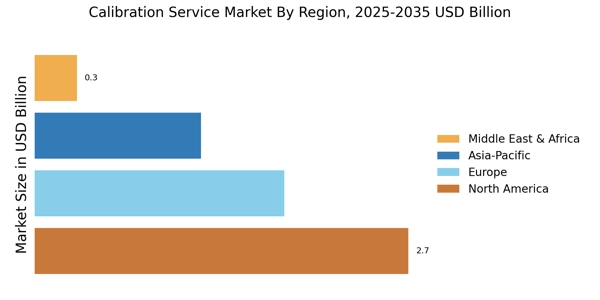The Calibration Service Market is currently characterized by a dynamic competitive landscape, driven by technological advancements and increasing demand for precision measurement across various industries. Key players such as Fluke Corporation (US), Ametek, Inc. (US), and Keysight Technologies, Inc. (US) are at the forefront, leveraging their extensive portfolios and innovative capabilities to enhance their market positions. Fluke Corporation (US) focuses on expanding its digital calibration solutions, while Ametek, Inc. (US) emphasizes strategic acquisitions to bolster its service offerings. Keysight Technologies, Inc. (US) is investing heavily in R&D to develop cutting-edge calibration technologies, which collectively shape a competitive environment that is increasingly reliant on innovation and technological prowess.
In terms of business tactics, companies are localizing manufacturing and optimizing supply chains to enhance operational efficiency and reduce lead times. The Calibration Service Market appears moderately fragmented, with a mix of established players and emerging firms. The collective influence of these key players is significant, as they not only set industry standards but also drive trends in service quality and technological integration.
In August 2025, Fluke Corporation (US) announced the launch of a new line of portable calibration tools designed for field use, which is expected to enhance service delivery in remote locations. This strategic move underscores Fluke's commitment to meeting the evolving needs of its customers, particularly in industries where precision is paramount. The introduction of these tools may potentially strengthen Fluke's market share by appealing to a broader customer base seeking reliable and efficient calibration solutions.
In September 2025, Ametek, Inc. (US) completed the acquisition of a leading calibration service provider, which is anticipated to expand its service capabilities and geographic reach. This acquisition aligns with Ametek's strategy to enhance its competitive edge through diversification and increased service offerings. By integrating this new entity, Ametek may improve its operational efficiencies and provide a more comprehensive suite of calibration services to its clients.
In July 2025, Keysight Technologies, Inc. (US) launched a new AI-driven calibration software that automates the calibration process, significantly reducing time and human error. This innovation reflects Keysight's focus on digital transformation and positions the company as a leader in the integration of AI technologies within the calibration sector. The software's capabilities could potentially redefine industry standards, making calibration processes more efficient and reliable.
As of October 2025, the Calibration Service Market is witnessing trends such as digitalization, sustainability, and AI integration, which are reshaping competitive dynamics. Strategic alliances among key players are becoming increasingly common, fostering collaboration that enhances technological capabilities and service offerings. Looking ahead, competitive differentiation is likely to evolve from traditional price-based competition to a focus on innovation, technology integration, and supply chain reliability, as companies strive to meet the growing demands of precision and efficiency in calibration services.


















Leave a Comment